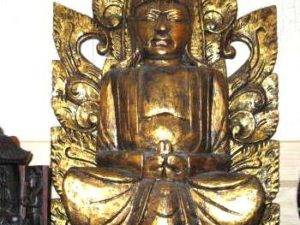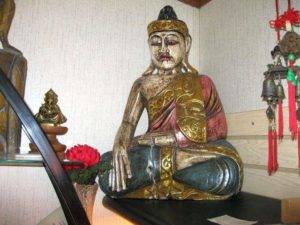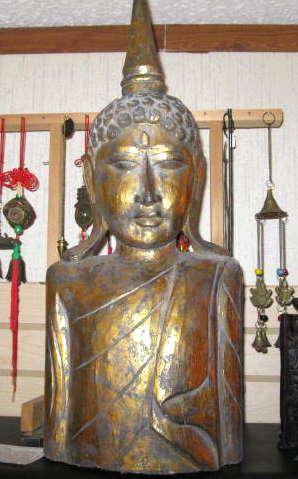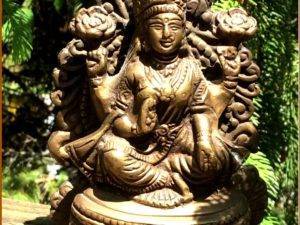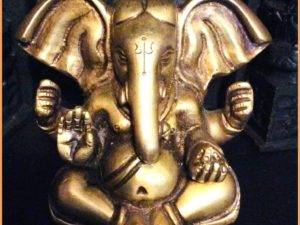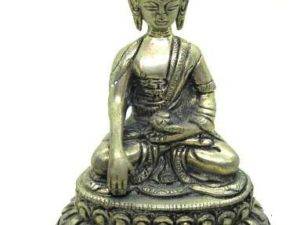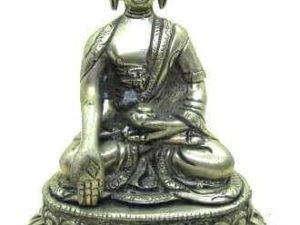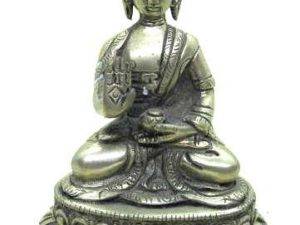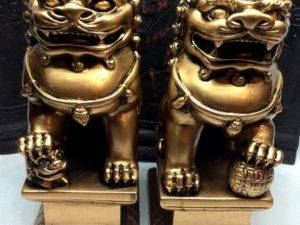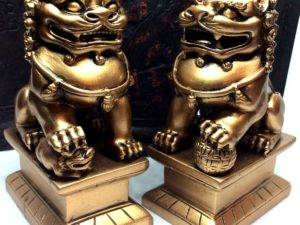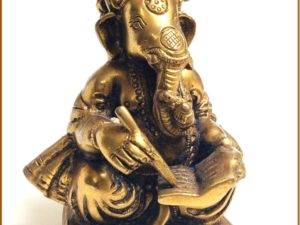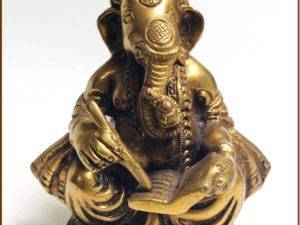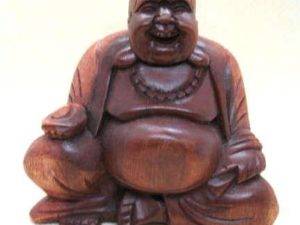Feng Shui Statues - Blessings Bestowed
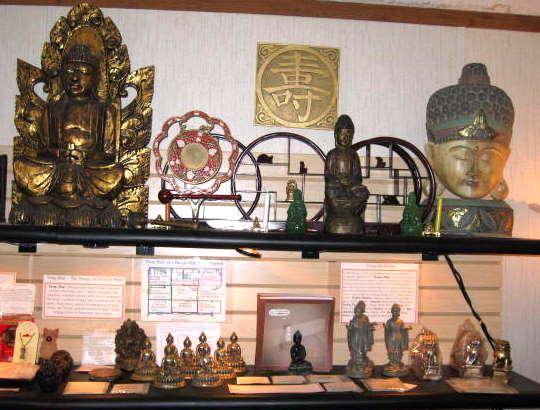
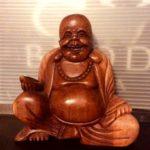
HAPPY BUDDHA, LAUGHING BUDDHA
Known as Hotei (Japan) and Pu-Tai (China), these figures embody the ideals of the good life: i.e. health, happiness, prosperity and longevity.
They represent the later Buddhist notions that the good life was indeed attainable in this world. It consisted of self-mastery, a happy demeanor, purposeful endeavor, a deep commitment to the welfare of others and enlightened awareness.
Scholars believe that the Laughing Buddha is in fact modeled on an historical figure, a fat wandering Zen monk named Pu-tai. All sources describe him as obese, with wrinkled forehead, and a white protruding belly which he left uncovered. There was another feature of his bodily appearance that captured attention. Wherever he went, he wore a pu-tai (Japanese Hotei) or cloth-bag. Thus he came to be known as Pu-tai Hoshang or hemp-bag monk. Legend has it that in this bag he carried candy for the children. Over the centuries within China, Buddhist notions of happiness based on self-mastery and enlightened insight were fused with popular Chinese life-ideals of happiness through material prosperity, thus today the hemp sack may be interpreted as filled with gold, filled with happiness, health, and other aspects of abundance.
*****************************************************************
Blessing Buddha
A BRIEF HISTORY OF BUDDHA
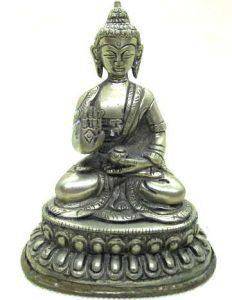 Gautama Buddha was born in 563 b.c. in northeast India. The Buddha was the son of the King of the Sakyas. Suddhodana, who ruled at Kapilavastu, on the border of Nepal. His mother was Queen Maya. He was named Siddhartha. He lived amidst the pleasures of palace life and at age 16 he was married to Princess Yasodhara. They had a son named Rahula. After seeing a decrepid old man, an invalid, and an ascetic beggar, he learned of suffering and decided to embrace asceticism. Soon afterwards, at age 29, Siddhartha left the palace and his family and went to a hermitage where he became the monk Gautama, or, as he is still called, Sakyamuni (The ascetic of the Sakyas). One day, meditating under a sacred figtree, he attained perfect illumination (Bodhi). He had become a Buddha. From there on he traveled and preached for 44 years what was to become one of the main religions of the world. He died at Kusinagara at age 80
Gautama Buddha was born in 563 b.c. in northeast India. The Buddha was the son of the King of the Sakyas. Suddhodana, who ruled at Kapilavastu, on the border of Nepal. His mother was Queen Maya. He was named Siddhartha. He lived amidst the pleasures of palace life and at age 16 he was married to Princess Yasodhara. They had a son named Rahula. After seeing a decrepid old man, an invalid, and an ascetic beggar, he learned of suffering and decided to embrace asceticism. Soon afterwards, at age 29, Siddhartha left the palace and his family and went to a hermitage where he became the monk Gautama, or, as he is still called, Sakyamuni (The ascetic of the Sakyas). One day, meditating under a sacred figtree, he attained perfect illumination (Bodhi). He had become a Buddha. From there on he traveled and preached for 44 years what was to become one of the main religions of the world. He died at Kusinagara at age 80
Showing 1–12 of 23 resultsSorted by price: high to low
-
Feng Shui Statues - Blessings Bestowed
Golden Sitting Buddha
$625.00 Add to cartGolden Sitting Buddha – wood statue, 15 inches wide, 24 inches tall, 8 inches deep and weighs 4.2 pounds.
Rated 0 out of 5Add to Wishlist ♥Add to Wishlist ♥ -
Feng Shui Statues - Blessings Bestowed
Large Wood painted Sitting Buddha
$525.00 Add to cartLarge Wood painted Sitting Buddha – wood statue, 15 inches wide, 24 inches tall, 8 inches deep and weighs approx. 10 pounds.
Rated 0 out of 5Add to Wishlist ♥Add to Wishlist ♥ -
Feng Shui Statues - Blessings Bestowed
Golden Wood Buddha Mask & Chest
$360.00 Add to cartGolden Wood Buddha Mask & Chest – wood statue 24 inches tall, 10 inches wide, 4 inches deep and weighs 4.4 pounds
Rated 0 out of 5Add to Wishlist ♥Add to Wishlist ♥ -
Feng Shui Statues - Blessings Bestowed
Small Wood Sitting Buddha
$225.00 Add to cartSmall Sitting Buddha – wood statue, 4.5 inches wide, 11.5 inches tall, weighs 1 lb, 10 ozs.
Rated 0 out of 5Add to Wishlist ♥Add to Wishlist ♥ -
Feng Shui Gifts for Energy Harmony
Brass Shiva
$140.00 Add to cartBrass Shiva – 5 1/2 inches tall by 4 inches wide.
Rated 0 out of 5Add to Wishlist ♥Add to Wishlist ♥ -
Feng Shui Gifts for Energy Harmony
Ganesha
$92.00 Add to cartBrass Ganesha – 3 inches tall by 4 inches wide.
Rated 0 out of 5Add to Wishlist ♥Add to Wishlist ♥ -
Feng Shui Statues - Blessings Bestowed
Bhumisparsa Mudra Brass Buddha
$54.00 Add to cartBhumisparsa Mudra – Gesture of Touching the Earth – brass statue, 4.5 inches tall by 3.5 inches wide by 2.5 inches deep and weighs over 1/2 pound.
Rated 0 out of 5Add to Wishlist ♥Add to Wishlist ♥ -
Feng Shui Statues - Blessings Bestowed
Varda Mudra – Gesture of Charity Brass Buddha
$54.00 Add to cartVarda Mudra – Gesture of Charity or Conferring Grace – brass statue 4.5 inches tall by 3.5 inches wide by 2.5 inches deep and weighs over 1/2 pound.
Rated 0 out of 5Add to Wishlist ♥Add to Wishlist ♥ -
Feng Shui Statues - Blessings Bestowed
Abhaya Mudra Brass Buddha
$54.00 Add to cartAbhaya Mudra – Gesture of Protection – brass statue 4.5 inches tall by 3.5 inches wide by 2.5 inches deep and weighs over 1/2 pound.
Rated 0 out of 5Add to Wishlist ♥Add to Wishlist ♥ -
Feng Shui Gifts for Energy Harmony
Feng Shui FU TEMPLE DOGS
$44.00 Add to cartSet of 2 gold resin Fu Dogs.
Rated 0 out of 5Add to Wishlist ♥Add to Wishlist ♥ -
Feng Shui Gifts for Energy Harmony
Lord Ganesha Writing the Mahabharta
$35.00 Add to cartLord Ganesha Writing the Mahabharta – 4 inches tall by 2 inches wide, brass
Rated 0 out of 5Add to Wishlist ♥Add to Wishlist ♥ -
Feng Shui Statues - Blessings Bestowed
Carved Wood Buddha – Medium
$35.00 Add to cartM4 Carved Wood Buddha 5 inches tall by 4 inches wide
Rated 0 out of 5Add to Wishlist ♥Add to Wishlist ♥

